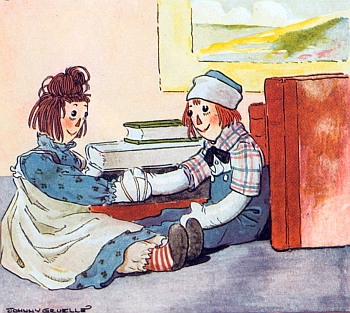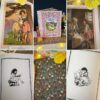Children’s Classic Read 2019

The exact details of the origins of the Raggedy Ann doll and related stories, which were created by Johnny Gruelle, are not specifically known, although numerous myths and legends about the doll’s origins have been widely repeated. Gruelle biographer and Raggedy Ann historian Patricia Hall notes that the dolls have “found themselves at the center of several legend cycles—groups of stories that, while containing kernels of truth, are more myth than they are history. What makes this even more intriguing is that fact that Johnny Gruelle, either unwittingly or with the great sense of humor he was known for, initiated many of these legends, a number of which are continuously repeated as the factual history of Raggedy Ann and Andy.”

Hall further explains that according to an oft-repeated myth, Gruelle’s daughter, Marcella, brought from her grandmother’s attic a faceless cloth doll on which the artist drew a face, and that Gruelle suggested that Marcella’s grandmother sew a shoe button for a missing eye. Hall says the date of this supposed occurrence is given as early as 1900 and as late as 1914, with the locale variously given as suburban Indianapolis, Indiana, downtown Cleveland, Ohio, or rural Connecticut. More likely, as Gruelle’s wife, Myrtle, reported, it her husband who retrieved a long-forgotten, homemade rag doll from the attic of his parents’ Indianapolis home sometime around the turn of the twentieth century before the couple’s daughter was born. Although the incident is unconfirmed, Myrtle Gruelle recalled, “There was something he wanted from the attic. While he was rummaging around for it, he found an old rag doll his mother had made for his sister. He said then that the doll would make a good story.” Myrtle Gruelle also indicated that her husband “kept [the doll] in his mind until we had Marcella. He remembered it when he saw her play with dolls…. He wrote the stories around some of the things she did. He used to get ideas from watching her.”
Additionally, Gruelle did not create Raggedy Ann as a tribute to his daughter following her death at 13 from an infected vaccination; Hall notes Gruelle’s May 28, 1915, U.S. Patent D47,789 application for the design of the prototype that became the Raggedy Ann doll was already in progress around the time that Marcella fell ill, and the artist received final approval by the U.S. Patent office on September 7, 1915, the same month as Marcella’s death. Nonetheless, the anti-vaccination movement adopted Raggedy Ann as a symbol, though Marcella died from an infected vaccination, not from the side effects of the vaccination itself.

Raggedy Ann has charmed millions of readers with her warm and optimistic outlook and unflappable approach to difficulties, while Raggedy Andy has pleased these same readers with his adventurous spirit and compassionate nature. As Gruelle’s granddaughter said, “these stories contain nothing to cause fright, glorify mischief, excuse malice, or condone cruelty.” All the original stories are included here, and all are guaranteed to delight and inspire

I look forward to reading these stories with my morning coffee in November. Grateful for books and coffee.


